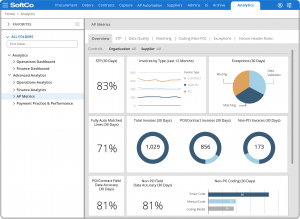In a world where efficiency and process improvements are top priorities for business growth, CFO KPIs are extremely important for assessing performance and feeding into subsequent reporting and decision-making.
Key performance indicators, or KPIs, are used to monitor various aspects of business performance. For KPIs to be impactful, they must be tied to business strategy, they must be measurable, and they must be actionable.
Many companies still use spreadsheets and manual processes to follow KPIs, and as a result, there is a global trend to move towards more automation, even for non-financial KPIs. An automation solution has the capability to identify KPIs and continuously monitor them for change, so you don’t have to manually track KPIs for reporting.
There is no shortage of financial and non-financial indicators to choose from. However, don’t use them all. Choose 8-10 ‘measures that matter’ and build reporting of these top CFO dashboard metrics into your weekly reporting routine. You can change your chosen KPIs as you focus on different areas of your business. We’ve listed 10 KPIs every CFO needs to track, regardless of your company’s size or industry.
1. Days to Close
This metric defines the number of days required to close the books and create reports for management at financial year-end. Using manual processes, closing cycles can be anything from one day for a small company to 24 days for a larger business. Leading finance departments following best practices and using automation for repetitive tasks should expect to close in around 5-6 days. This KPI can also be used to track month-end close cycles.
2. Accounts Payable Turnover
Accounts payable turnover is the number of times per year that your company pays off vendors and other expenses. This ratio gives visibility of how much cash your company uses to pay vendors at various stages and how this may affect cash flow.
3. Accounts Receivable Turnover
Key performance indicators for a Chief Financial Officer need to include the organization’s ability to convert credit sales to cash – and this is why businesses track the Accounts Receivable turnover. This KPI measures the number of times per year that you collect money owed to the business. If the collection process does not happen frequently enough, it may damage the company’s cash flow health. If the process happens too frequently, it may be adding unnecessary cost to the business and may not be providing enough time for your debtors to pay.
This CFO performance measure allows you to assess whether your company’s collection process is sufficient and enables decision-making for improvements of the process if necessary.

Fig. 1. A finance automation solution helps CFOs gain complete visibility over their chosen KPIs
4. Days Payable Outstanding
The days payable outstanding (DPO) KPI measures the average number of days that your company takes to pay creditors. It is important to track this in order to understand if there are bottlenecks during the payment process and at which stage(s) they occur. If invoices are being delayed for payment at the approval or matching stages, recurring issues can be identified with this KPI. If improvements are required, your organization can expect to pay creditors on time and, when possible, can pay early and take advantage of any early payment discounts.
5. Days Sales Outstanding
Days sales outstanding (DSO) is used to estimate the average sales collection period. It is an indication of how well your organization’s accounts receivables are being managed. Monitoring this KPI allows your finance department to identify recurring late-paying companies and help decision-making by introducing incentives for prompt or early payment using discounts, for example.
6. Payment Error Rate
The payment error rate quantifies the percentage of payments from debtors or to creditors that were not completed as a result of processing errors. These errors could be down to system or human error, for example a missing purchase order reference, no approval for payment, missing related documents etc.
7. Working Capital
Effectively managing working capital ensures that organizations are always in a position to meet their short-term liabilities. Working capital is calculated by subtracting current liabilities from current assets, including assets such as available cash, short-term investments, and accounts receivable.
8. Current Ratio
The current ratio takes your assets (including cash, receivables, marketable securities, and inventory amounts) and current liabilities (including any debt and accounts payable amounts) to help you understand your company’s ability to pay short-term liabilities.
9. Quick Ratio/Acid Test
This KPI gauges a company’s liquidity and is a more conservative assessment of financial health than the current ratio because it excludes inventories from the total asset amount.
10. Debt to Equity Ratio
This measures how your organization is funding its growth and how effectively you are using shareholder investments. If a high debt-to-equity ratio exists, it suggests that your organization is using debt to enable growth. Monitoring these KPIs for CFO performance highlights the importance of discussing means of financing your business with the senior management team and shareholders.


